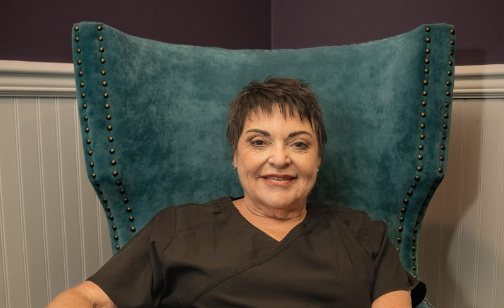PART 1 of 2: Q & A with Ms. Vickie Mickey
Vickie Mickey’s career has had a far-reaching impact in her home state of Ohio where she has worked as an electrologist, business owner, cosmetic therapy school founder, educator, and licensing advocate for over three decades. (Certainly, the night she testified before the State Medical Board of Ohio to enable electrologists to be licensed for laser hair removal sounds like the climax of a movie! Check tomorrow’s post to hear the full story.) Ms. Mickey’s stories about the ebb and flow of Ohio state regulation for cosmetic therapy and electrolysis are instructive both about what can cause changes to licensing rules and how the effects of these rules impact the professionals working in an industry.
Historically, Ohio is the only state in the U.S. that licensed electrologists under the more broadly defined role of Cosmetic Therapists. Because of this, the terms Electrologist and Cosmetic Therapist are used interchangeably in this profile of Ms. Mickey. Until 2021, electrologists wishing to practice in Ohio were required to have 750 hours of training including instruction in electrolysis, physiology, and anatomy, as well as cosmetic therapy.
Although Ms. Mickey is an electrologist and laser technician (she views laser as just another hair removal modality), she is first and foremost a Cosmetic Therapist. In fact, the school that she founded in 2011 is called Cosmetic Therapy Training Center (CTTC). She has served as President of both the International Guild of Professional Electrologists and the Cosmetic Therapy Association of Ohio and has served on the State Medical Board Ohio Advisory Committee.
Information about her businesses can be found here:
About Face Cosmetic Therapy Center
https://columbuslaserhairremoval.com/about/
https://www.facebook.com/AboutFaceCTC
https://www.instagram.com/aboutfacectc/
Cosmetic Therapy Training Center
https://www.facebook.com/cosmetictherapytrainingcenter/
Ms. Mickey, please explain the term Cosmetic Therapist since electrologists working outside of Ohio may not have experience with that title.
“Today, Cosmetic Therapy includes specialized training both in electrolysis and in the use of epilators or other mechanical cosmetic equipment to provide cosmetology treatments. Students receive instruction not only in electrolysis theory and practice but also in the use of electronic apparatus to perform cosmetic treatments such as anaphoresis, cataphoresis, and facial massage.
“For electrologists, understanding cosmetic therapy can provide a vital tool. For example, the epilator I use includes regimens for both lymphatic drainage and facial massage, and during the facial massage, I can use galvanic current to relieve oils from comedones. Glycolics, cleansing regimens, and anaphoresis can also help to remove these blemishes, but using my epilator’s regimen gives me another option that may be especially beneficial to particular clients.
“I regularly use anaphoresis and cataphoresis during client treatments. Anaphoresis is phenomenal for opening tight follicles before electrolysis (in my experience, this is most commonly needed when epilating fine hairs). And just recently, I used anaphoresis while applying a topical anesthetic to the face of an MtF patient who was experiencing extreme pain during electrolysis after having undergone facial feminization surgery (FFS). By using anaphoresis to ‘drive in’ the application of the anesthetic, the patient was able to be comfortable and complete their treatment. In my office, cataphoresis is used primarily to reduce swelling and discomfort. I spray witch hazel on a tissue and use a roller to do venous flow (toward the heart), and this does a beautiful job of helping to begin the client’s healing process.”
A Brief Summary of Ohio’s Licensing Standards for Cosmetic Therapists
From 1952 to 2021, Ohio was the only state in the U.S. that licensed Cosmetic Therapists. With her home and business located in the capital city of Columbus, perhaps it was inevitable that Ms. Mickey would be drawn into work on the state’s licensing initiatives. At the time she completed her training in 1984, newly educated cosmetic therapists were required to be licensed by both the State Medical Board (SMB) and the State Board of Cosmetology (SBC) after having 500 hours of training.
Later that same year, Ohio’s education requirements for licensed cosmetic therapists were dramatically changed. This change was a result of advocacy by Kree (an epilator manufacturer) who had a stated goal of placing electrologists in every J.C. Penny’s, Macy’s, Sears, etc., attempting to mirror the success of the many established hair salons that had been established in the department stores, a popular trend at the time. Kree’s lobbying efforts were successful and led to both the reduction of required training hours from 500 to 120 and the elimination of the requirement that electrology practitioners were licensed through the State Medical Board (SMB).
Ms. Mickey, how did you become involved in crafting new state licensing standards after the 1984 licensing changes?
“After the licensing changes made in 1984, the tests were too stringent- only 50% of new applicants could pass them. I was a proctor for the practical exams administered by the State Board of Cosmetology (SBC), and I saw first-hand how the changes in licensing requirements affected students taking the exams.
“A turning point for me was when the President of the SBC and I got into an argument after an exam. I had failed a young woman who had come from an unlicensed state. He said, ‘How can she have worked in another state and then come here and fail?’ and I responded, ‘Because she didn’t epilate the hair properly, and that’s why I’m here.’ We really got into it over that, but I remained adamant that she shouldn’t pass unless she was capable of doing the job.
“After that meeting, I was approached by members of the Cosmetic Therapy Association of Ohio (CTAO) where discussions were taking place about how to craft new legislation around industry standards. At first, I had no idea how to help with these initiatives. I met with other Cosmetic Therapists who were nurses and had been practicing for some time- Jeanne Sweeney in particular was a great advocate for holding strong cosmetic therapy standards in Ohio. I began as Recording Secretary, then Vice-President and eventually President of the CTAO. My career began to extend ‘outside the door’ the door of my office as I began going to lots of meetings and even visiting the community college where the CT curriculum was to be established- a two and half hour drive from Columbus. It was a lot of work, but I felt driven to do this work!
“The CTAO ultimately hired a lobbyist to work on legislation for our industry and used the lobbyist’s help to set new standards for our profession. As a result, cosmetic therapy licensing was once again returned to the Medical Board, training requirements were increased to 750 hours, education in facial massage reinstated, and annual continuing education was required- and at that time, there were auditors who would check whether individual electrologists were fulfilling their continuing ed requirements! The final version of the legislation went into statute in 1993 and lasted until 2021.
“With no new changes on the horizon, the CTAO stopped employing a lobbyist in 2019, and we were all taken by surprise when Ohio removed the licensing requirement for cosmetic therapists in 2021. The governor at the time believed that Ohio licensing was too restrictive and formed a business barrier for people moving in from out of state; his solution was to eliminate licensing. No one knew this change was coming- even the State Medical Board that was charged with granting licenses wasn’t given prior notice of the change. Today in Ohio, licenses are no longer required to practice electrolysis. Notably, the licensing requirement for laser practitioners has not been eliminated. To offer laser treatments, a practitioner must complete 775 hours of education including 50 hours of laser education, must pass a national certification exam administered by the Society of Clinical and Medical Hair Removal (SCMHR), and administer their first laser treatment under the supervision of a physician.”
_____________________________________



Laissez un commentaire